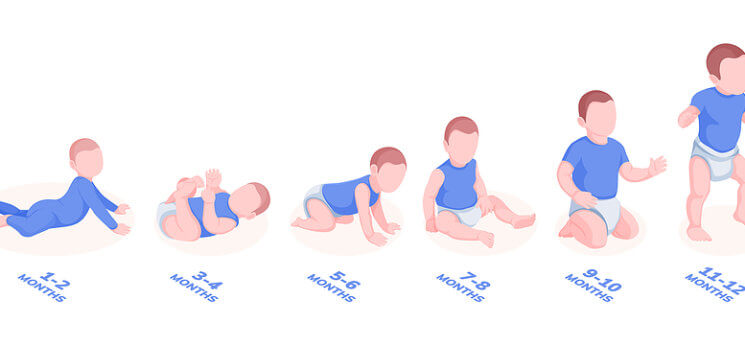In their first months, new babies are developing in the blink of an eye. From sleeping constantly as newborns to giggling and taking first steps by one year, it’s a total shift — and hard to keep track of all the changes that should be taking place.
To take some of the guesswork away and give you a frame of reference, we’ve highlighted some of the major milestones your pediatrician will be tracking during the first visit. You can watch for these, too, so you know how your baby is growing and changing — and tell your doctor if you have any concerns. Mention it to your pediatrician if your baby doesn’t seem to be on pace.
Everything You Need to Know About First-Year Milestones:
Birth to 3 Months:
Personal-Social Skills
• Recognizes faces
• Smiles responsively and spontaneously
• Regards his hands
Gross Motor Skills
• Begins to hold her head up
• Can sit with head steady
• Starts bearing weight on legs
Fine Motor Skills
• May hold hands together
Language Skills
• Begins to “ooh” and “ahh”
• Laughs
• Squeals
3 to 6 Months:
Personal-Social Skills
• Will work for a toy
• Begins to feed herself
Gross Motor Skills
• Can lift his head and chest from tummy
• Rolls over
• Sits without support
Fine Motor Skills
• Begins reaching and looking for things
Language Skills
• Turns to the sound of your voice
• Imitates speech
• Starts speaking in single syllables
6 to 9 Months:
Personal-Social Skills
• Will play pat-a-cake
• Indicates her wants
• Begins to wave “bye”
Gross Motor Skills
• Pulls himself to standing position
• Stands alone while holding on
Fine Motor Skills
• Takes one or two items at a time
• Bangs items together to make noise
• Begins grasping with thumb and finger (pincer grasp)
Language Skills
• Begins combining syllables
• Jabbers
• Starts saying “mama” and “dada” (non-specific)
9 to 12 Months:
Personal-Social Skills
• Will play ball with others
• Begins to imitate activities
• Starts drinking from a sippy cup
Gross Motor Skills
• Stands alone
• Begins walking
Fine Motor Skills
• Can put a block into a cup
Language Skills
• Starts saying “mama” and “dada” (specific)
• Begins speaking one or two simple words at a time
These milestones are taken from the Denver Developmental Screening Test, which is a reference pediatricians use to assess if your baby is on track.
Here’s how to read it: Each milestone is represented by a dual-colored box, spanning a given length of time that doctors considered “normal” for development. The white area indicates that 75 percent of babies will reach a given milestone in that timeframe, whereas the shaded box represents the remaining 25 percent of children — still considered normal, but time to start watching to make sure your baby is able to perform each skill. “The shaded area indicates caution,” says Dr. Turner.




